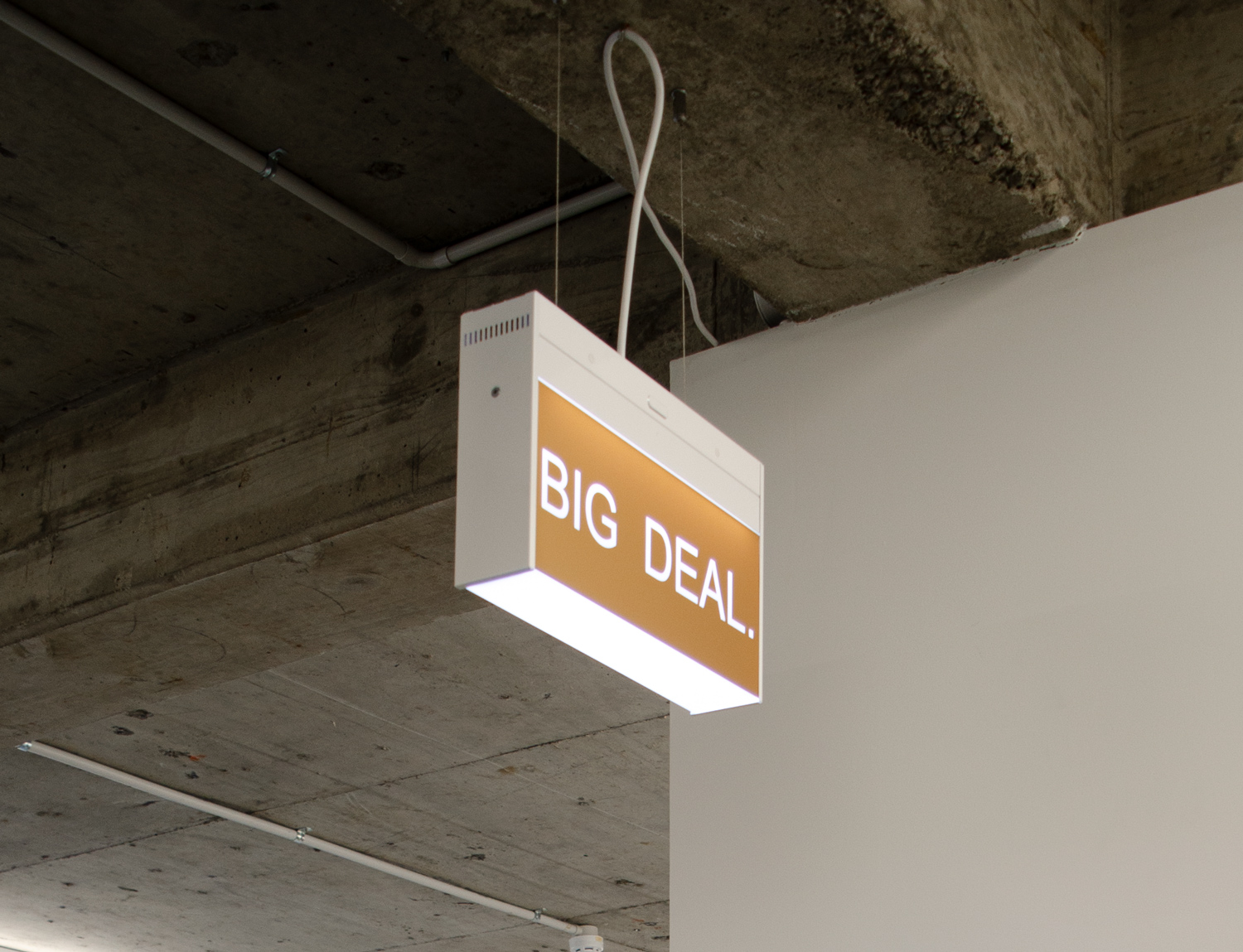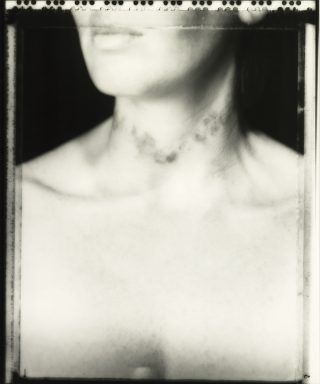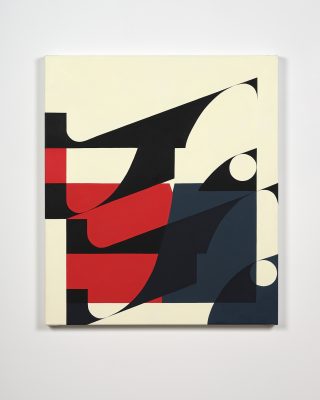Elisabeth Pointon sends me a video via Instagram. She has just received the central work for her new show, WHERE TO FROM HERE—no question mark. On screen, a fan fills an enormous inflatable form the dusty black of tyres. The camera/phone, presumably wielded by the artist, moves along the face of the work to reveal the expression ‘BIG TIME.’—with full stop. The text puts me in mind of Microsoft WordArt. It’s assertively 3D. Viewed from the side, the letters are sort of duplicated, in part, I guess, to help them stand up. They’re ribbed like the panels of a puffer jacket or a stack of inner tubes. It’s Michelin Man writing, only not white. The setting for the video shores up the automotive vibe. It’s Pointon’s everyday place of work, a car showroom. She is testing the inflatable out on a large mezzanine. What luck. Where else would she have found seven plus meters of carpet-softened floor?

Elisabeth Pointon, BIG DEAL., 2020. Image courtesy of the artist and Jhana Millers, Te Whanganui-a-Tara Wellington.
There’s additional relevance to the showroom location, beyond its convenient scale. The place has had an outsized influence on Pointon’s practice for some time. Her works, typically sculptural and text-based, have often chimed with dealership advertising devices, such as banners and blimps. BIG TIME. is not a little reminiscent of a flailing tube man. The phrases Pointon favours—‘BIG DEAL.’, ‘SPECTACULAR.’, ‘PHENOMENAL.’—are the ebullient language of sales floors. She tends not to recreate longer slogans, but keeps her expressions tight. Just one word, maybe two. In doing so, she allows the complexity of fairly minimal bits of language to be explored. ‘Big deal’ alone can yield a great deal of colour. It’s a substantial sale under negotiation at a showroom or a high-end dealer gallery. It’s a person who matters in The Culture. It’s a verbal retort to hearing about something that doesn’t matter to you.
Pointon’s preference is for terms that move through various domains or registers. ‘Phenomenal’ is colloquial but also has more specialist, and more ‘sophisticated’, senses. A dossier of information compiled by the artist while planning WHERE TO FROM HERE includes a break-down of the word and its root, ‘phenomenon’. One definition of ‘phenomenon’: ‘A knowable thing or event’. Another, classified as philosophical: ‘An experienced object whose constitution reflects the order and conceptual structure imposed upon it by the human mind (especially by the powers of perception and understanding)’. Which gets me wondering: Where do semantically complex terms turned into sensuous objects fit in? Are Pointon’s works perhaps super-phenomenal?

Elisabeth Pointon, BIG TIME., 2020. Image courtesy of the artist and Jhana Millers, Te Whanganui-a-Tara Wellington.
Opinion: one of the most beguiling aspects of Pointon’s practice is the way in which it plays with the relationship between subjective experience and communication. It’s a commonplace that words and works of art can be interpreted in diverse ways. Dictionaries list multiple senses, the artist can’t control audience reactions, etc. Pointon embraces such slipperiness. At the same time, she retains a keen interest in the potential of collective understanding and action. Indeed, her works attest to these things to an uncommon extent, not least because they clearly depend on interpersonal interactions. They do not masquerade as entities of individual authorial genius. They involve facilitators and manufacturers (whom the artist consistently acknowledges). They invite engagement. We audience-members are summoned to read them, quite literally. They make sense. They appeal to us. Or, rather, they appeal to me. I really want to jump on the BIG TIME.
*
But let’s take a step back. The dossier I’ve mentioned was handed to me at a meeting over drinks. Pointon brought along her flatmate and fellow artist Robbie Handcock, who has written lucidly on her work, and who collaborates with her on Glad We Did That, a tongue-in-cheek ‘vlog’ series concerning ‘all things art, culture and lifestyle in Wellington’. I can’t resist reading the meeting as a sort of private performance. Robbie as manager. Elisabeth as entrepreneur pitching her project to me. She refers to her orderly ring-bound book of emails and essays and plans. Details of special import have been highlighted or inscribed on lime green Post-it Notes. She’s a little bit honour student—stationery on point. She’s a little bit organised office worker. She’s a lot savvy art-maker. It suddenly occurs to me that Pointon is sizing me up as well. Where’s my preparation?

Elisabeth Pointon, PHENOMENAL., 2020. Image courtesy of the artist and Jhana Millers, Te Whanganui-a-Tara Wellington.
Handcock is also present in order to act as a support person. Pointon has been shown at a number of large public institutions of late, including the Dowse Art Gallery in Te Awakairangi, Christchurch Art Gallery Te Puna o Waiwhetū, and City Gallery Wellington Te Whare Toi. Her experiences have taught her to go into meetings with someone else in tow, someone who can help her assess the experience later on. A witness. Pointon is acutely conscious of being mucked about by galleries, as evidenced by the presence in the dossier of a printout of a 2019 essay by Anisha Sankar, which examines institutional gaslighting and the ‘ghostly phenomenon’ of white supremacy.[1] In the past, Pointon has gone into meetings alone and come out feeling like she’s not been heard or taken seriously. She’s come out feeling like things are suss, but also feeling like the only one with that interpretation. It’s unsettling.
Pointon is a woman. She is also queer and of Indian heritage. She enters situations with an acute awareness of systemic flaws. An important element of her work is ‘institutional critique’. She responds to the failings of big-deal galleries, gallerists, and curators in ways pointed and subtle. Her projects are often outlandishly grand. Recognising that artists like her are still shown relatively seldom by public institutions, she seizes opportunities to occupy the most space that she can. She pushes the limits of what an early-career artist might be expected to achieve. When she is not blowing up the phrase ‘BIG TIME.’, she’s having a banner emblazoned with ‘SPECTACULAR.’ flown about the sky.[2] She favours block capitals, clean typefaces, bold colours like black and red (Pointon notes that they relate to anarchism). She likes the punch and finality of a full stop. She loves making you look.

Elisabeth Pointon, WHERE TO FROM HERE, 2020. Image courtesy of the artist and Jhana Millers, Te Whanganui-a-Tara Wellington.
But she is also sensitive to the fact that, no matter what she does, she is at risk of being side-lined, or made into a token. From the outside, she is now a big-time artist. But being such an artist is not a straightforward experience. Things have been especially tough for Pointon of late, for reasons personal and global. Between climate catastrophe, the pandemic, and unending police brutality, 2020 has been a big time for us all. A lot to take in. A lot to take, period. At the same time, Pointon likes to imagine that the mess we’re in could stimulate big change. Included in the dossier is a second, more recent essay by Sankar, which reflects on what it might mean to ‘reclaim our agency in crisis’.[3] Pointon has taken a highlighter to the writer’s observation that ‘crisis’ relates to a Greek term meaning ‘to decide’. So, decision time. Look around the gallery, choose your preferred exit sign. Statement or question, it’s up to you. Or, rather, it’s up to us.
*
Essay commissioned by Jhana Millers to accompany the exhibition WHERE TO FROM HERE.
WHERE TO FROM HERE
Elisabeth Pointon
10 September to 3 October 2020
Jhana Millers
Te Whanganui-a-Tara Wellington
[1] Anisha Sankar, ‘Who’s the Real Problem?: On White Supremacy and Institutional Gaslighting’, Pantograph Punch, 4 June 2019, https://www.pantograph-punch.com/posts/white-supremacy-institutional-gaslighting.
[2] Robbie Handcock, ‘WOULD YOU LOOK AT THAT: In Conversation with Elisabeth Pointon’, Hainamana, 14 March 2019, https://www.hainamana.com/would-you-look-at-that-in-conversation-with-elisabeth-pointon/.
[3] Anisha Sankar, ‘Capitalism + Cyborgs: Imagining Change in Time of Crisis’, Pantograph Punch, 10 July 2020, https://www.pantograph-punch.com/posts/reflections-cyborg.



